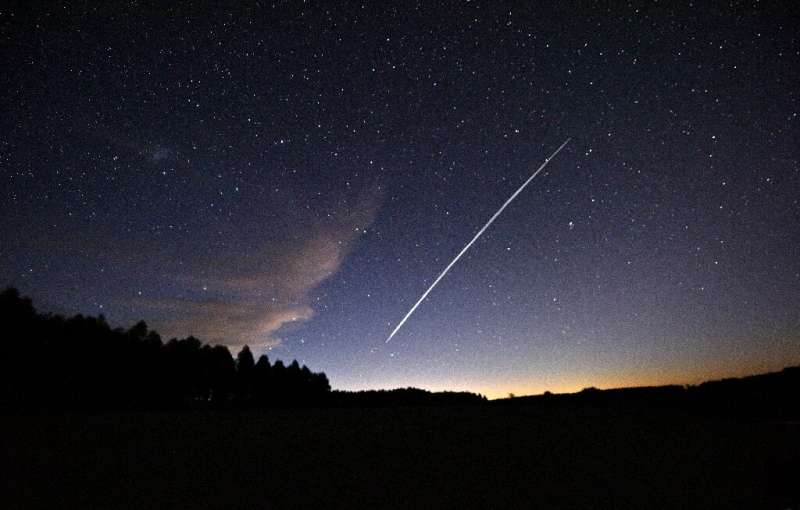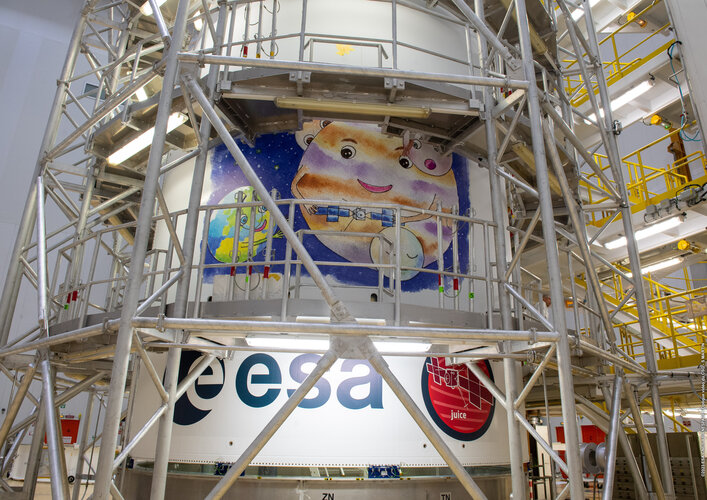Astronomers sound alarm about light pollution from satellites
Monday, 20 March 2023 20:01
Astronomers on Monday warned that the light pollution created by the soaring number of satellites orbiting Earth poses an "unprecedented global threat to nature."
The number of satellites in low Earth orbit have more than doubled since 2019, when US company SpaceX launched the first "mega-constellation," which comprise thousands of satellites.
An armada of new internet constellations are planned to launch soon, adding thousands more satellites to the already congested area fewer than 2,000 kilometers (1,250 miles) above Earth.
Each new satellite increases the risk that it will smash into another object orbiting Earth, creating yet more debris.
This can create a chain reaction in which cascading collisions create ever smaller fragments of debris, further adding to the cloud of "space junk" reflecting light back to Earth.
GMV partnership to bring revolutionary precise positioning services to Australia and New Zealand
Monday, 20 March 2023 19:46
These days, satellite positioning systems play a fundamental role in our society. We are constantly surrounded by this technology, and it has been fully integrated into our lives.
Mars exploration and the debate about planetary protection
Monday, 20 March 2023 16:11
Could planetary protection considerations hinder our plans to send humans to Mars?
Earth observation supports latest UN climate report
Monday, 20 March 2023 14:30
The final instalment of the sixth assessment report by the United Nations' Intergovernmental Panel on Climate Change (IPCC) has been released today. The report warns that the planet has already warmed 1.1°C above pre-industrial levels, resulting in more frequent and intense extreme weather events that are causing increasingly dangerous impacts on nature and people in every region of the world.
The report includes a greater contribution of Earth observation data than its previous iterations in providing the physical evidence of Earth’s changing climate system – from sea-level rise, growing greenhouse-gas emissions and melting sea ice.
Ariane 5 rocket decorated with winning Juice artwork
Monday, 20 March 2023 13:18 Image:
A close up of an Ariane 5 rocket surrounded by scaffolding. In the centre of the Ariane 5 is the sticker showing the artwork (blue background with Jupiter, three icy moons, Earth and Juice.
Image:
A close up of an Ariane 5 rocket surrounded by scaffolding. In the centre of the Ariane 5 is the sticker showing the artwork (blue background with Jupiter, three icy moons, Earth and Juice. Arkisys and partners to show how they would build a satellite in orbit
Monday, 20 March 2023 13:03
The U.S. Space Force awarded a $1.6 million contract to a team led by Arkisys to demonstrate robotic satellite assembly.
ATL Partners forms new holding company focused on space and air sensors
Monday, 20 March 2023 09:05
ATL Partners, a private equity firm, announced March 20 it has formed a new holding company called LightRidge Solutions to oversee a portfolio of space and airborne sensors businesses
ESA’s exoplanet missions
Monday, 20 March 2023 08:00 Video:
00:00:57
Video:
00:00:57
More than 5000 exoplanets have been discovered to date, but what do they look like? ESA’s dedicated exoplanet missions Cheops, Plato and Ariel are on a quest to find out. Cheops will focus its search on mini-Neptunes, planets with sizes between Earth and Neptune, on short orbits around their stars. Cheops will find out how large these planets are, and may detect whether the planets have clouds. Plato will look at all kinds of exoplanets and determine their sizes and ages. Plato’s instruments are so sensitive it may discover the first Earth-like planet on an Earth-like orbit.
Space industry deals with launch shortage
Sunday, 19 March 2023 23:36
Even as the space industry complains of a shortage of launch capacity, SpaceX said it has room to increase an already surging pace of launches.
Investigation will test 3D printed materials for satellite manufacturing
Sunday, 19 March 2023 10:11 As 3D printed rockets, car parts, and even homes begin to hit the market on Earth, L3Harris Technologies aims to leverage the International Space Station (ISS) National Laboratory in its search for durable materials to 3D print satellite components. Before 3D printed materials can be used to build more sustainable and efficient parts for spacecraft, they must be tested to ensure they can withsta
As 3D printed rockets, car parts, and even homes begin to hit the market on Earth, L3Harris Technologies aims to leverage the International Space Station (ISS) National Laboratory in its search for durable materials to 3D print satellite components. Before 3D printed materials can be used to build more sustainable and efficient parts for spacecraft, they must be tested to ensure they can withsta Head of Space Force testifies before Senate panel on $30B budget
Sunday, 19 March 2023 10:11 U.S. Space Force Chief of Space Operations Gen. Chance Saltzman testified before a Senate subcommittee on Tuesday, one day after the Space Force released its $30 billion budget.
Space Force's budget request for the 2024 fiscal year is 13 percent higher than last year, with $19 billion for funding the development of satellites, ground systems, and enabling technology.
Tuesday's hearin
U.S. Space Force Chief of Space Operations Gen. Chance Saltzman testified before a Senate subcommittee on Tuesday, one day after the Space Force released its $30 billion budget.
Space Force's budget request for the 2024 fiscal year is 13 percent higher than last year, with $19 billion for funding the development of satellites, ground systems, and enabling technology.
Tuesday's hearin Adtran and Satelles partner to deliver Satellite Time and Location alternative to GNSS
Sunday, 19 March 2023 10:11 Adtran, Inc and Satelles, Inc.,jave announced a strategic partnership. The collaboration will enable operators of critical infrastructure to safeguard their timing networks with Satellite Time and Location (STL) technology. By integrating Satelles' STL into its Oscilloquartz network synchronization products, Adtran will provide an alternative to GNSS systems or a way to augment them with enhance
Adtran, Inc and Satelles, Inc.,jave announced a strategic partnership. The collaboration will enable operators of critical infrastructure to safeguard their timing networks with Satellite Time and Location (STL) technology. By integrating Satelles' STL into its Oscilloquartz network synchronization products, Adtran will provide an alternative to GNSS systems or a way to augment them with enhance Intelsat to operate air pollution monitoring space instrument
Sunday, 19 March 2023 10:11 Intelsat, operator of one of the world's largest integrated satellite and terrestrial networks and leading provider of inflight connectivity (IFC), completed testing of the operational and data collection system for the first space-based instrument to monitor major air pollutants across the North American continent every daylight hour at high resolution. The new UV-visible spectrometer, operated
Intelsat, operator of one of the world's largest integrated satellite and terrestrial networks and leading provider of inflight connectivity (IFC), completed testing of the operational and data collection system for the first space-based instrument to monitor major air pollutants across the North American continent every daylight hour at high resolution. The new UV-visible spectrometer, operated Earth Map and users work together for an eco-friendly world
Sunday, 19 March 2023 10:11 Rapid access to information is one of the largest barriers we have to deal with as a group of people in the Internet Age. Earth Map is a free application designed to be easily used and accessible to anyone with an internet connection and the desire to observe any environment at any time, with zero expertise (or travel) required.
This new tool features an intuitive point-and-click way of in
Rapid access to information is one of the largest barriers we have to deal with as a group of people in the Internet Age. Earth Map is a free application designed to be easily used and accessible to anyone with an internet connection and the desire to observe any environment at any time, with zero expertise (or travel) required.
This new tool features an intuitive point-and-click way of in China's Shenzhou-15 astronauts to return in June
Sunday, 19 March 2023 10:11 China's Shenzhou-15 crew is scheduled to return to Earth in June, the China Manned Space Agency (CMSA) said Sunday.
The space station combination is operating steadily, and the Shenzhou-15 astronauts are in good condition, said the CMSA.
China will launch three space missions for the space station application and development this year, including the cargo craft Tianzhou-6 and the cre
China's Shenzhou-15 crew is scheduled to return to Earth in June, the China Manned Space Agency (CMSA) said Sunday.
The space station combination is operating steadily, and the Shenzhou-15 astronauts are in good condition, said the CMSA.
China will launch three space missions for the space station application and development this year, including the cargo craft Tianzhou-6 and the cre 
